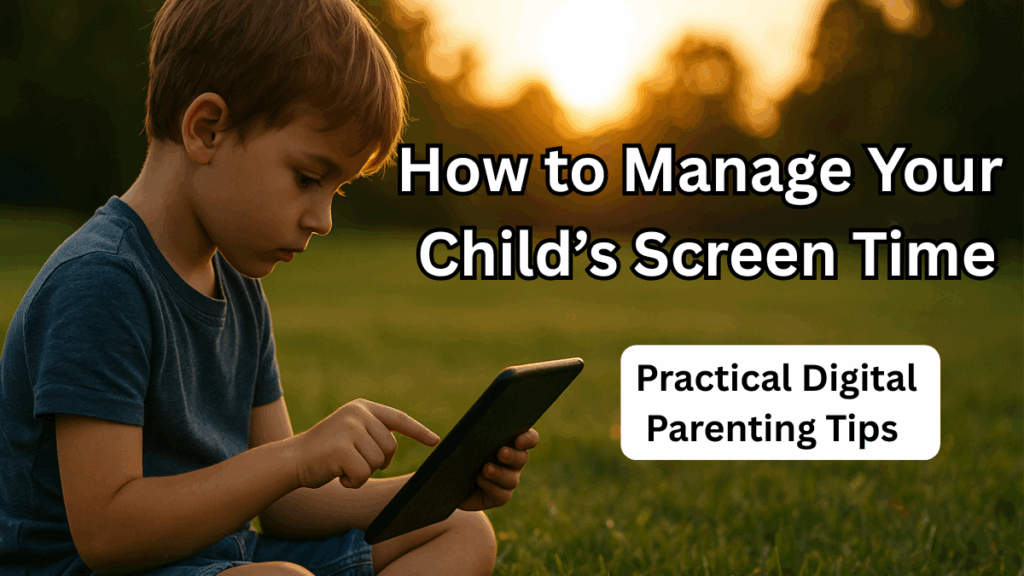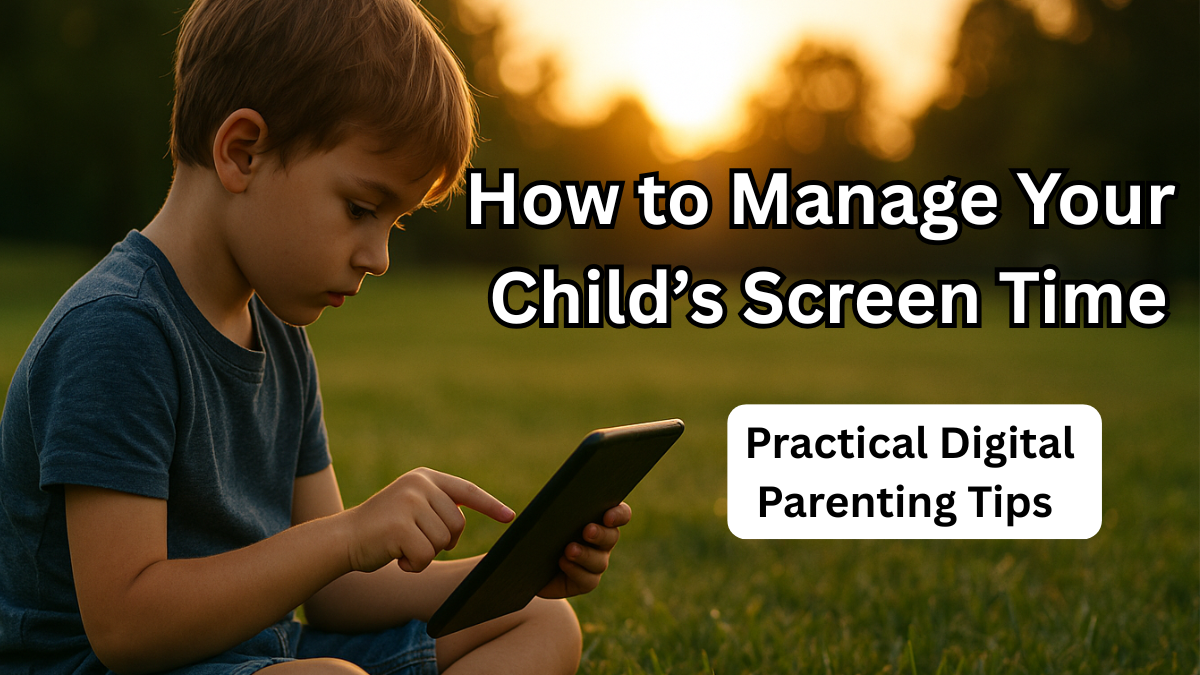In 2025, parenting comes with a new set of challenges—one of the most pressing being how to manage your child’s screen time. From attending online classes to scrolling through Instagram reels, children today are exposed to screens more than ever before.
While technology offers immense educational value, overexposure can lead to a range of physical, emotional, and psychological issues. As parents, especially in Indian households where digital education and entertainment co-exist, finding a healthy balance is the need of the hour.
This guide offers Digital Parenting Tips for Indian Homes that are practical, culturally sensitive, and suited for today’s tech-savvy kids.

Why Managing Screen Time Is Critical in 2025
Technology is not the enemy—but lack of control is. Children are spending hours glued to devices, sometimes unknowingly harming their well-being. Here’s why parents need to take charge:
-
Excessive screen time can cause poor posture, dry eyes, and headaches.
-
Lack of physical activity leads to obesity and stunted social development.
-
Children may develop sleep disorders and emotional dependency on gadgets.
-
Unrestricted access may expose them to inappropriate or harmful content.
Adopting the right Child Screen Time Guidelines ensures a healthier physical and mental development in your child’s growing years.
Updated Child Screen Time Guidelines for Different Age Groups
Use this table as a baseline to set age-appropriate screen time limits:
| Age Group | Recommended Screen Time (Per Day) | Purpose/Notes |
|---|---|---|
| 0 – 2 years | None (except video chats with family) | Encourage touch, interaction, and real-world stimuli |
| 2 – 5 years | Max 1 hour (co-viewed) | Content must be educational and age-appropriate |
| 6 – 12 years | Max 2 hours (non-academic) | Include breaks and encourage offline hobbies |
| 13 – 18 years | Max 3 hours (non-academic) | Promote digital balance and regular supervision |
These Child Screen Time Guidelines are not about rigid enforcement but building digital discipline through positive routines.
Practical Digital Parenting Tips for Indian Homes
Every household is different, but the common goal remains the same: to raise responsible and emotionally balanced children. These Digital Parenting Tips for Indian Homes can help create a healthy digital culture at home.
H4. Build a Customized Family Media Plan
A media plan sets expectations and creates boundaries without confrontation.
-
Define daily screen time limits clearly.
-
Allocate time for online learning, leisure, and family time.
-
Identify screen-free zones like the dining room and bedrooms.
-
Set “no gadget” times—like during meals or before bedtime.
H4. Promote Engaging Offline Alternatives
Children often use screens to escape boredom. Offering alternatives reduces this reliance.
-
Enroll them in hobby classes—painting, sports, music, or drama.
-
Schedule weekly trips to parks, museums, or libraries.
-
Encourage hands-on activities like Lego building, crafts, or storytelling.
-
Create a reward system for screen-free accomplishments.
H4. Co-Watch and Co-Play With Intention
Instead of allowing passive screen consumption, be part of the digital journey.
-
Sit down and watch YouTube videos, movies, or play games together.
-
Discuss the content—what they liked, disliked, or learned.
-
Use digital tools as starting points for conversations.
H4. Be a Digital Role Model
Children notice everything—especially your screen habits.
-
Don’t scroll through your phone during meals or bedtime.
-
Let your child see you reading physical books or newspapers.
-
Take digital detox weekends as a family.
H4. Leverage Tech to Tame Tech
Use technology to control its own impact.
-
Enable parental controls to restrict explicit or violent content.
-
Install screen time monitoring apps.
-
Use device settings to set timers, bedtime modes, and app limits.
-
Encourage the use of educational tools like digital flashcards or coding games.
Warning Signs of Screen Dependency in Children
Pay close attention to the early signs of unhealthy screen habits. If left unchecked, they can lead to deeper problems.
-
Child becomes irritable or aggressive when devices are taken away
-
Avoids outdoor play, group activities, or family time
-
Sleep patterns are erratic or disrupted
-
Drop in school performance or attention span
-
Secrecy or lying about online activity
If you observe these signs frequently, it’s time to intervene and reset your approach.
Sample Digital Day Plan for a 10-Year-Old Child
A structured day can help your child manage their time wisely. Here’s a simple example:
| Time Slot | Activity |
|---|---|
| 7:00 – 8:00 AM | Wake up, hygiene routine, light exercise |
| 8:00 – 2:00 PM | School hours (online/offline) |
| 2:00 – 3:00 PM | Lunch and quiet time |
| 3:00 – 4:00 PM | Reading, drawing, or creative play |
| 4:00 – 5:00 PM | Outdoor games or physical activity |
| 5:00 – 6:00 PM | Limited supervised screen time (games/shows) |
| 6:00 – 7:30 PM | Homework, revision, or storytelling |
| 7:30 – 9:00 PM | Dinner, music, and bedtime routine |
Long-Term Benefits of Healthy Screen Management
When digital boundaries are respected at home, your child is more likely to:
-
Develop better emotional regulation
-
Build real-world friendships and social skills
-
Perform better in school due to improved concentration
-
Sleep better and feel more rested
-
Cultivate independent hobbies and interests
By applying these Digital Parenting Tips for Indian Homes, you’re not just protecting your child—you’re empowering them to grow into mindful, balanced individuals.
FAQs
What is the ideal amount of screen time for a 6–12-year-old child?
According to Child Screen Time Guidelines, children aged 6–12 should ideally have no more than 2 hours of non-educational screen time per day. This excludes school-related activities.
How can I discipline my child without making screen restrictions seem like punishment?
Instead of punishment, focus on reward systems. Celebrate screen-free milestones with special activities or treats. Make screen-time rules a family agreement rather than an order.
Should I be concerned if my child uses educational apps for hours?
Yes. Even educational content needs to be consumed in moderation. Children need time for physical play, family bonding, and rest. Excessive screen time—even for learning—can impact health.
Are there Indian apps or tools for monitoring screen usage?
Yes. Some useful tools popular among Indian parents in 2025 include:
-
Google Family Link – for Android devices
-
Apple Screen Time – for iOS users
-
Tata ClassEdge Parental Mode – Indian curriculum–based
-
Qustodio & Norton Family – cross-platform control apps
These tools allow parents to track screen time, set app limits, and ensure safe browsing environments.
Final Thoughts
Parenting in the digital age isn’t about eliminating screen time—it’s about creating a healthier relationship with technology. By setting boundaries early and following these Digital Parenting Tips for Indian Homes, you are giving your child the tools to thrive both online and offline.
Be consistent. Be patient. And most importantly, be involved. Because parenting doesn’t stop when the screen turns on—it starts there.
Click here to learn more
